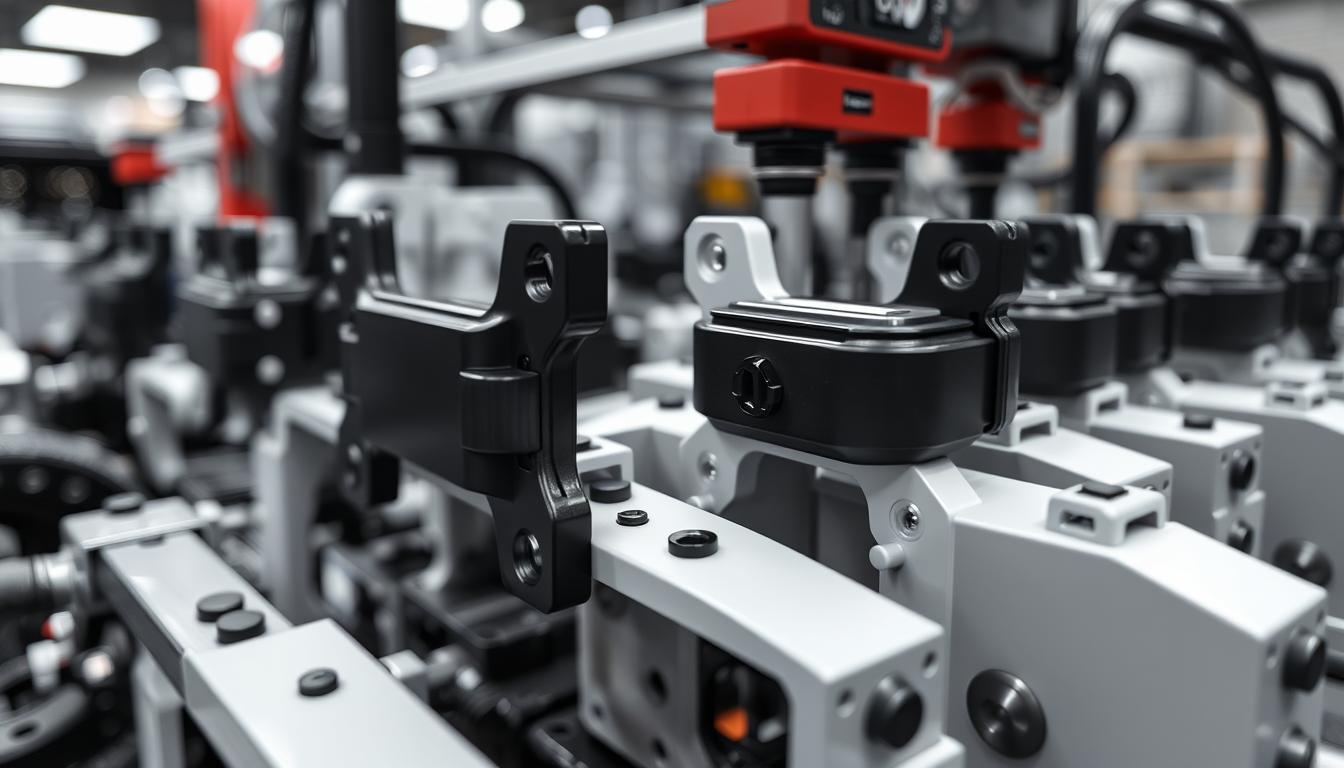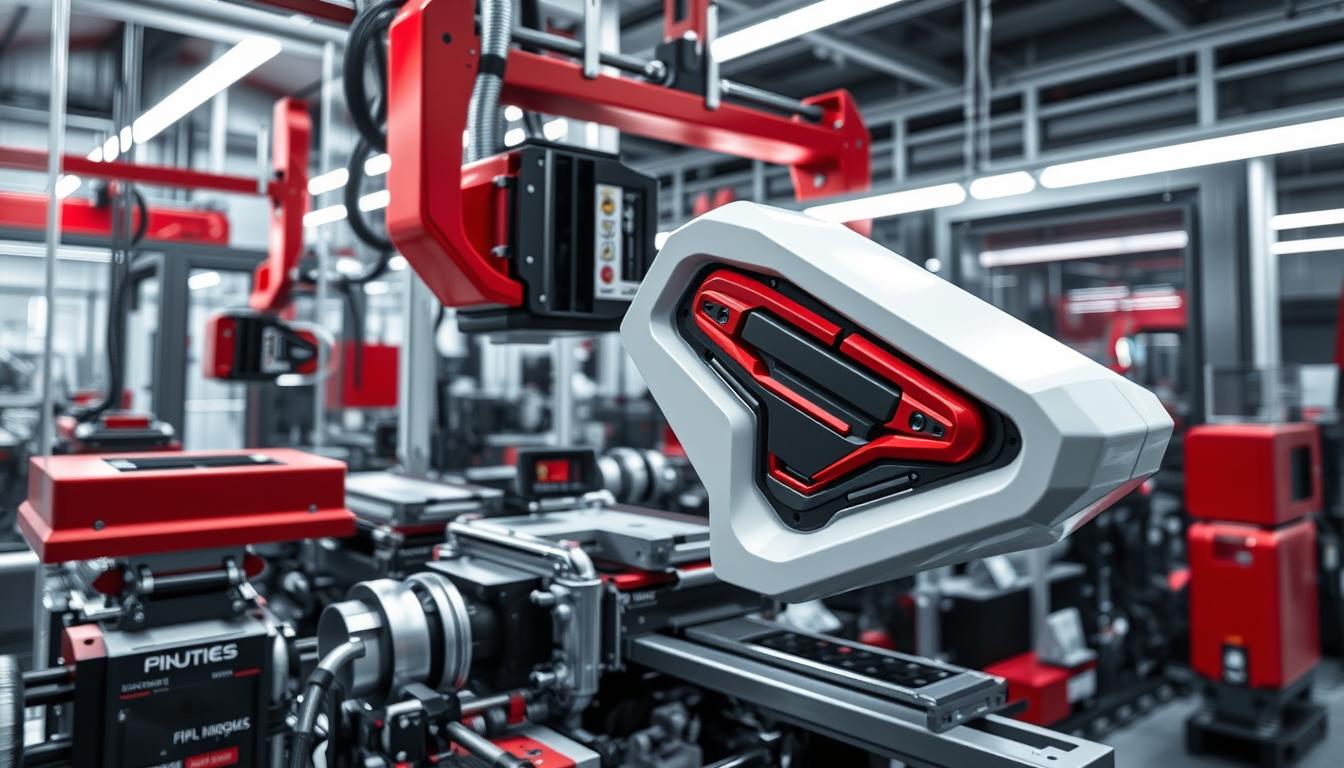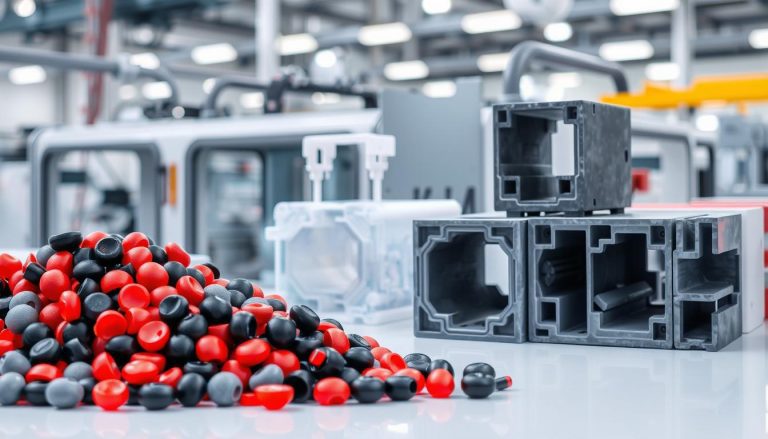This article is about film joints in injection molding. These parts are very important in modern production. They offer new manufacturing solutions for many areas.
We explain how to develop, design and manufacture film joints. We also show why they are so useful. We also explain where they are used and how they are made.
Key findings
- Film joints enable innovative production solutions.
- Injection molding is an efficient method for manufacturing film joints.
- Film joints offer a wide range of possible applications.
- The quality and design specifications are crucial.
- The use of CAD software improves the design process.
- Sustainability is playing an increasingly important role in production.
What are film joints?
Film joints are special connecting elements that are made from a flexible material. They flexibly connect two rigid elements. This is important if you need controlled movements.
The functionality of film joints is based on their flexibility and resilience. They enable dynamic movements that are precise and stable. This makes them ideal for many technical applications.
There are many examples of applications for film joints in industry. They are particularly popular in the automotive industry. Complex movements and stable connections are important there.
Film joints are also in demand in the electrical industry. Often in products that require flexibility and stability.
The advantages of film joints in injection molding
Film joints are very flexible. They can move in several directions without breaking or wearing out.
They are also very robust. They remain dimensionally stable and functional even under heavy loads.
The injection molding process makes production more efficient. It enables fast and cost-effective production, which is very important for companies.
Film joints are versatile. They can be manufactured in many shapes and materials to meet special requirements.
| Advantage | Description |
|---|---|
| Flexibility | Enables movement in different directions without material fatigue. |
| Robustness | Maintains its shape and functionality under high loads. |
| Efficiency | Enables fast and cost-efficient production. |
| Versatility | Made in different shapes and materials to adapt to specific needs. |
Film joints during injection molding - design & production
The design and production of film joints in injection molding are very important. First, the concept of the joint is designed. This is done using modern CAD software that enables precise work.
Next comes prototype production. Here we test the film joints in real life. These tests give us valuable insights for production.
Once the tests have been completed, production begins. Injection molding enables series production. This allows us to produce quickly and in large numbers. Good planning and teamwork ensure that everything runs smoothly.
Cooperation creates an effective production process. This enables us to guarantee the best quality. You can find more information on materials used in injection molding in our article on polymethyl methacrylate (PMMA).
| Phase | Activity | Result |
|---|---|---|
| Design | Concept development with CAD software | Visual design of the joint |
| Prototyping | Production and testing of prototypes | Validation of functionality |
| Production | Setting up the injection molding process | Series production of film joints |
Areas of application for film joints
Film joints are used in many industries. Their flexibility makes them very valuable. They adapt well to different needs.
In the automotive industry, film joints connect moving parts. They ensure precise and reliable movements. They are also important in electronics, especially in medical technology. Precise movements are crucial there.
In mechanical engineering, film joints improve the efficiency of machines. They make moving parts more flexible. Many companies rely on film joints to improve their products.
If you would like to find out more about manufacturing parts, visit our manufacturing solutions page.
The manufacturing process of film joints
The manufacturing process for film joints is very complex. It requires precise planning and modern technology. The first step is to select the right raw materials. These are important for the performance and durability of the joints.
This is where modern injection molding processes come into play. This technology ensures high precision. This is very important for film joints. Innovative methods achieve the best results.
Post-processing is an important part of the process. It ensures that everything is exactly as it should be. This ensures that the joints function correctly later on. Careful post-processing maintains the high quality of the industry.
Materialien für Filmgelenke
The right materials for film joints are important. They determine how well they work and where they can be used. There are many materials in the industry that fulfill special tasks.
- Plastics: Polypropylene and polyethylene are very common. These plastics are flexible and durable. This makes them a good choice for many applications.
- Elastomers: These materials are very stretchy. They are great for moving parts. Especially when flexibility is important.
- High-performance plastics: Materials such as PEEK or PTFE are ideal for special conditions. These plastics are very resistant. They help to make the film joints durable.
The right choice of materials improves the performance of the film joints. This makes them more efficient in many areas.
The role of CAD software in the design process
CAD software is very important in the design process of film joints. It helps to make accurate designs that are important for manufacturing. Modern CAD tools enable engineers to work faster and more efficiently.
This speeds up the entire innovation process.
A major advantage of CAD software is the ability to simulate movements. These simulations test how film joints work before they are manufactured. This saves a lot of time because problems can be solved at an early stage.
The software is also highly customizable. Engineers can make changes quickly. This makes development faster and reduces risks.
Effective use of CAD software brings great efficiency to the design process.
Quality control and testing of film joints
The quality of film joints is very important. They are used in many industries. Thorough quality control ensures that they work well.
Various tests help to check the performance of the film joints. This allows us to measure their flexibility and strength.
- Test methods: There are various tests. These include tensile, compression and bending tests. These methods help us to determine the physical properties.
- Certifications: Film joints often have to be certified according to international standards. This guarantees high quality. We can only achieve these standards through recognized tests.
- Long-term tests: These tests show us how film joints react under extreme conditions. They help us to identify and rectify weaknesses at an early stage.
Careful quality control is very important. It ensures that the joints function well under different conditions. Through testing, we understand not only the current properties, but also possible long-term effects.
| Test method | Purpose | Frequency |
|---|---|---|
| Tensile | test Determination of tensile | strength Each batch |
| Pressure | test Compressive strength test | Every few months |
| Bending | test Analysis of flexibility | If required |
| Long-term | testing Evaluation under extreme conditions | Annually |
Through systematic testing and close quality control, we ensure that our film joints are of the highest quality. Modern testing methods increase the reliability of our products. This is how we build our customers’ trust in our manufacturing solutions.
Innovations in the field of film joints
There are constant innovations in the field of film joints. These change materials and production methods. New plastics and elastic materials are extending the service life of film joints. These developments help manufacturers and users.
The new technologies are also improving production. Robotics and automated processes make production cheaper and faster. This leads to shorter production times and greater flexibility.
Digitale Transformation spielt auch eine große Rolle. Künstliche Intelligenz und Machine Learning optimieren Design– und Produktionsabläufe. Diese Innovationen erlauben es Unternehmen, ihre Produkte zu verbessern und den Marktbedarf zu decken.

| Area | Innovations | Advantages |
|---|---|---|
| Materials | High-performance plastics and elastic materials | Longer service life of the film joints |
| Production methods | Automation and robotics | Cost efficiency and shorter production times |
| Digital technologies | AI and machine learning | Optimization of design and production processes |
Innovations in the field of film joints are driven by constant research. New technologies enable companies to offer customized solutions. This significantly increases their competitiveness.
Sustainability in the production of film joints
Sustainability is very important in the production of film joints. There is a growing awareness of the environment. That’s why we have to make responsible decisions.
An important point is the choice of materials. When we use recyclable materials, we show that we value the environment. At the same time, innovative manufacturing processes help to make production lines more efficient. This allows us to significantly reduce our CO2 footprint.
- Choice of materials: Use of recyclable and environmentally friendly materials.
- Energy efficiency: Modern processes greatly reduce energy consumption.
- Waste management: Better processes reduce waste during production.
Good waste management improves the environment and makes the process more economical. Sustainability is not just a trend. It is a necessity in the production of film joints in order to meet the demands of a conscious market.
Challenges in the production of film joints
The production of film joints is not easy. Material procurement is often a major obstacle. The availability of materials can cause problems.
It is important to constantly work on adapting technology. This keeps you competitive. Film joints must constantly adapt to market requirements. This requires flexibility and creativity.
To solve problems, you have to be proactive. Companies should develop strategies to avoid material shortages. New technologies should be integrated.
Close cooperation with suppliers helps to overcome challenges. This can increase efficiency in production.
Future outlook for film joints in injection molding
The future of film joints in injection molding looks promising. New technologies play a major role. IoT technologies could increase efficiency and offer new monitoring options.
Smart manufacturing is becoming more and more real. It shows that we need to become faster and more flexible. Companies need to find out about new technologies.
Demand is growing due to customized products. Manufacturers need to be faster and more flexible. Current technologies help them to react quickly and develop new products.
You can find examples of innovative products here. They use bio-based materials.
Research focuses on material improvements. New materials could make film joints better and more sustainable. The combination of technology and materials is crucial.

In summary, film joints are important for the future of manufacturing technologies. Pressure to innovate and new solutions are shaping the industry. This brings challenges and opportunities.
Conclusion
Film joints in injection molding are very important for many industrial applications. They are flexible and robust. They also help to find future-oriented solutions that meet modern market requirements.
Film joints are essential for high-quality products. They enable creative designs that are functional and aesthetically pleasing. Further development in material technology and production methods opens up new ways to increase performance and improve sustainability.
We believe that film joints will play an important role in the future. Through constant innovation and quality control, they remain a driving force in the industry. They help us to always offer competitive and efficient solutions.
FAQ
Was sind Filmgelenke?
Film joints are joints made of flexible materials. They are important when flexibility is required. They are particularly useful in injection molding.
What are the advantages of film joints in injection molding?
They are very flexible and robust. This makes them efficient in production. This is good for industrial applications.
How is the manufacturing process for film joints carried out?
First you select the materials. Then they are injected. Then they are carefully processed to ensure quality.
What materials are used for film joints?
Plastics such as polypropylene and polyethylene are often used. Elastomers also offer good elasticity. PEEK or PTFE are also available for special cases.
What role does CAD software play in the design process for film joints?
CAD software helps to make designs accurate. You can simulate movements and adapt models quickly. This makes the process more efficient.
How is the quality of film joints ensured?
The flexibility and strength are tested using various methods. There are also certifications according to international standards. This ensures high standards.
What innovations are there in the area of film joints?
There are new plastics and elastic materials. Advances in robotics and automation are also improving production.
How is sustainability taken into account in the production of film joints?
Recyclable materials and energy-efficient processes are used. Waste management is also optimized to promote sustainability.
What are the challenges in the production of film joints?
Challenges include material procurement and technological progress. Market requirements must also be met.
What is the future outlook for film joints in injection molding?
The outlook is positive. There is technological progress and growing demand. Research is focusing on materials science.





